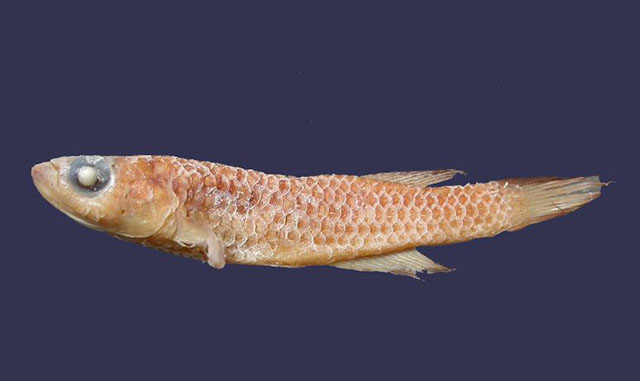|
Dorsal spines (total): 0-0; Dorsal soft rays (total): 10-13; Anal spines: 0-0; Anal soft rays: 14-15; Vertebrae: 29-29. Diagnosis: Aphyosemion teugelsi is placed within the Nothobranchiinae and Aphyosemina by the open frontal or nasal neuromast system with two separate grooves and the preopercular neuromast system with 6 pores; a closer relationship with Aphyosemion and not with Fundulopanchax is indicated by the number of circumpeduncular scales, and the more posterior placement of the dorsal fin relative to the anal fin (Ref. 85863). Aphyosemion teugelsi is distinguished from all other species of the subgenus Aphyosemion by the more anterior insertion of the dorsal fin over the anal fin, D/A 6-8 vs. D/A 8-13, and the longer base of the dorsal fin, 13.8-15.3% of standard length vs. 8.6-12.1%; it differs from all species of the subgenus Aphyosemion in having a larger head, head length 29.3-32.0% of standard length vs. 18.9-27.8%, and a larger eye diameter, 9.1-10.3% of standard length vs. 6.9-8.7%; Aphyosemion teugelsi has a higher and more convex back than the species of the subgenus Aphyosemion, dorsal height is 8.0-12.5% of the length of the spinal column vs. 6-10% (Ref. 85863). Males of A. teugelsi are distinguished by members of the subgenus Aphyosemion except A. congicum and A. ferranti by the absence of fin streamers on the edges of the caudal fin; with the exception of A. congicum, A. labarrei, A. ocellatum and A. passaroi, A. teugelsi males can be distinguished from other Aphyosemion males by the dark brown, in live most probably black, margin of all fins vs. fins with a light blue, white, yellow, orange, or reddish margin (Ref. 85863). Males can be distinguished from A. congicum populations from the adjacent Kwango basin by dark fin margins in all fins vs. dark margin only in unpaired fins; dorsal fin with a dark margin and centre with spots vs. almost completely black and, if with spots, only on the fin base; anal fin with broad black margin in A. teugelsi vs. very narrow or no black margin in A. congicum; caudal fin without spots in A. teugelsi and spotted in A. congicum; pectoral fin with black margin in A. teugelsi vs. white, light yellow, or bluish margin in A. congicum (Ref. 85863). Aphyosemion teugelsi can be distinguished from A. labarrei by several characters: flanks with a small number of small light spots, probably red in live, on anterior side in male vs. a dense pattern of large red spots, forming an irregular band in A. labarrei, and by the folling scale counts: lateral line scales 28-29, circumpeduncular scales 11-12 in A. teugelsi vs. 30-32 lateral line and 13-14 circumpeduncular scales in A. labarrei (Ref. 85863). From the two species of the Aphyosemion coeleste species group, A. ocellatum and A. passaroi, A. teugelsi can be separated by the absence of a dark blotch on mid of side slightly posterior to the insertion of pectoral fin vs. presence of a blotch in A. ocellatum, the black margin on upper and lower border of caudal fin vs. completely dark bordered caudal fin in A. passaroi, and from both species by the presence of traces of red dots in nearly regular rows, the dark margin of the pectoral fin, and extended posterior dorsal and anal fin rays vs. nearly complete absence or irregular distribution of red pigmentation on side, no dark pectoral fin borders, and only slightly extended posterior dorsal and anal fin rays from both species (Ref. 85863).
Description: A slender, laterally slightly compressed species; dorsal profile slightly convex, greatest body depth approximately at pelvic fin; ventral profile slightly convex from head to end of anal fin, concave on caudal peduncle (Ref. 85863). Snout slightly rounded, mouth directed upwards, lower jaw very robust and longer than upper jaw; dentary bears an outer row of large and inner irregular rows of smaller unicuspid, curved teeth; the premaxilla bears some larger and several smaller unicuspid and curved teeth (Ref. 85863). Frontal or nasal neuromasts in two separated grooves, the preopercular canal with six pores (Ref. 85863). Scales cycloid, entirely scaled except ventral surface of head; frontal squamation of G-type; scales on mid-longitudinal series 28-29, with 2-3 scales posterior to the hypural plate; 7-8 transversal scales; 11-12 scales around the caudal peduncle (Ref. 85863). Small dorsal fin with 10-13 fin rays, first dorsal fin ray inserts above the 6-8th anal fin ray; anal fin with 14-15 rays; posterior 4-5 dorsal and anal fin rays elongated in males, even in juveniles; caudal fin rounded, 23-25 rays, no extensions on upper and lower fin rays; pectoral fin with 14-15, pelvic fin with 5-6 rays (Ref. 85863). Male paratype with 29 vertebrae, 14 with haemal spines (Ref. 85863).
Colouration: Flanks light brown with abrupt transition to light ventral side; twenty to thirty small light spots mainly concentrated on anterior flanks in interrupted rows; in comparison with other species, of which live and preserved colour pattern is known, former red pigmentation in live specimens turned into light areas in formalin preserved specimens (Ref. 85863). All paired and unpaired fins bordered with a dark brown margin; dorsal fin with small light spots, which were in live fish probably red, on darker background; anal fin transparent, no spots, with broad dark margin; caudal fin transparent with broad dark upper and lower margins, pectoral and pelvic fins transparent with narrow dark margins; from comparison with other species, dark margins in preserved specimens usually correspond to dark brown to black margins in live colouration (Ref. 85863). Females: flanks light brown without markings except for the dark scale edges, forming a reticulated pattern; all unpaired fins and pelvic fins completely covered with a dense pattern of very small dark spots; pectoral fins completely transparent (Ref. 85863). |

